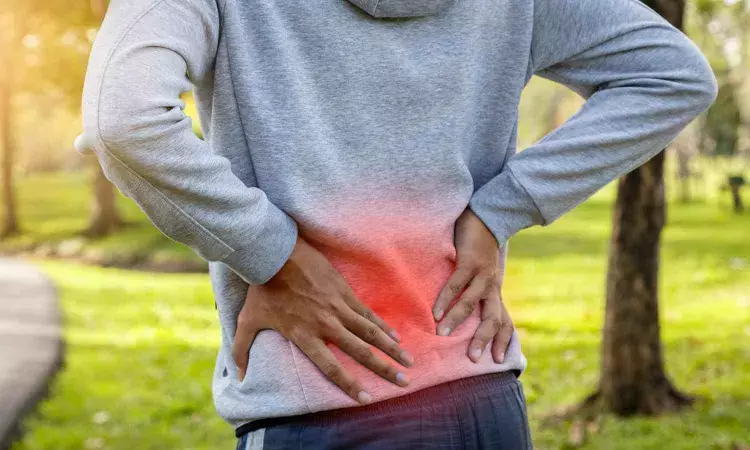- Home
- Medical news & Guidelines
- Anesthesiology
- Cardiology and CTVS
- Critical Care
- Dentistry
- Dermatology
- Diabetes and Endocrinology
- ENT
- Gastroenterology
- Medicine
- Nephrology
- Neurology
- Obstretics-Gynaecology
- Oncology
- Ophthalmology
- Orthopaedics
- Pediatrics-Neonatology
- Psychiatry
- Pulmonology
- Radiology
- Surgery
- Urology
- Laboratory Medicine
- Diet
- Nursing
- Paramedical
- Physiotherapy
- Health news
- Fact Check
- Bone Health Fact Check
- Brain Health Fact Check
- Cancer Related Fact Check
- Child Care Fact Check
- Dental and oral health fact check
- Diabetes and metabolic health fact check
- Diet and Nutrition Fact Check
- Eye and ENT Care Fact Check
- Fitness fact check
- Gut health fact check
- Heart health fact check
- Kidney health fact check
- Medical education fact check
- Men's health fact check
- Respiratory fact check
- Skin and hair care fact check
- Vaccine and Immunization fact check
- Women's health fact check
- AYUSH
- State News
- Andaman and Nicobar Islands
- Andhra Pradesh
- Arunachal Pradesh
- Assam
- Bihar
- Chandigarh
- Chattisgarh
- Dadra and Nagar Haveli
- Daman and Diu
- Delhi
- Goa
- Gujarat
- Haryana
- Himachal Pradesh
- Jammu & Kashmir
- Jharkhand
- Karnataka
- Kerala
- Ladakh
- Lakshadweep
- Madhya Pradesh
- Maharashtra
- Manipur
- Meghalaya
- Mizoram
- Nagaland
- Odisha
- Puducherry
- Punjab
- Rajasthan
- Sikkim
- Tamil Nadu
- Telangana
- Tripura
- Uttar Pradesh
- Uttrakhand
- West Bengal
- Medical Education
- Industry
Study Highlights Age, Gender, BMI, and Lifestyle as Key Factors in Managing Lower Back Pain

India: An observational study published in the Journal of the Association of Physicians of India revealed that Lower back pain is a complex condition shaped by factors such as age, gender, BMI, and lifestyle. To enhance patients' quality of life, management and prevention strategies must take these risk factors into account.
A holistic approach is crucial to effectively address the multifaceted causes of lower back pain, the researchers wrote.
Lower back pain is defined as the pain between the lower edges of the ribs and the buttocks. People at any age can experience Lower back pain. Lower back pain is divided into acute (<6 weeks), subacute (6 weeks to <3 months), and chronic (>3 months) based on duration. Risk factors associated with Lower back pain are physical factors, sociodemographic characteristics, lifestyle habits, and psychological factors. Sociodemographic factors have a great impact on Lower back pain. Considering this, Banshi Lal Kumawat, Senior Professor & Unit Head, Department of Neurology, Sawai Man Singh Medical College and Hospital, Jaipur, Rajasthan, India, et. al, conducted a study to analyze the risk factor and etiology profile of lower back pain among patients.
For this purpose, the research team conducted a cross-sectional observational study involving 170 patients from March 2023 to August 2023. Sociodemographic and lifestyle data were collected and diagnostic investigations which include X-ray and MRI were performed.
The study assessed several outcomes and based on the outcome, patients were categorized into acute and chronic Low Back Pain groups for further analysis. Patients with acute LBP (≤6 weeks) and Patients with chronic LBP (> 3 months). The magnetic resonance imaging of spine was done to assess the etiology of LBP. Pfirrmann grading was done for prolapsed intervertebral disk. Then the collected data were analyzed using SPSS 2021 version.
The findings revealed that:
- Patients under 35 years old had a higher prevalence of acute LBP, whereas those over 55 years old had a higher prevalence of chronic LBP.
- Compared to men, women had a greater frequency of LBP, with chronic LBP being more frequent in women.
- Talking about triggering events, coughing or sneezing was frequently associated with acute LBP, but hard weightlifting was a key trigger for chronic LBP.
- Patients with physically demanding employment had a higher risk of acute low back pain (LBP), but homemakers and unemployed people were more likely to experience chronic LBP.
- Overweight and obesity were linked to long-term low back pain. Compared to patients with acute LBP, those with chronic LBP were more likely to be using medication.
- Prolapsed intervertebral disk (PIVD), which is more common in patients with chronic low back pain, was the most common cause identified by MRI. Tumors, tuberculosis, vertebral fractures, and other spinal disorders were among the other etiologies.
“Age, gender, BMI and lifestyle factors influenced lower back pain. Proper management and preventive strategies help to improve the condition of the patients”, researchers concluded.
Reference
Kumawat, B. L., Kaur, I., & Parashar, V. S. (2024). An Observational Study of Various Risk Factors and Etiological Profile in Patients with Lower Back Pain at Tertiary Care Center. The Journal of the Association of Physicians of India, 72(7), 48–54. https://doi.org/10.59556/japi.72.0557
Deepanshi Bhatnagar (MSc Nutrition and Dietetics) is a professional with a master's degree in Nutrition and Dietetics from MRIIRS. With a strong academic background, she is well-versed in the principles of nutrition and dietary science. At Medical Dialogues, Deepanshi serves as the correspondent for fact-checking, where she is responsible for verifying and evaluating claims related to nutrition and diet, ensuring that all content is accurate, evidence-based, and scientifically sound.
Dr Kamal Kant Kohli-MBBS, DTCD- a chest specialist with more than 30 years of practice and a flair for writing clinical articles, Dr Kamal Kant Kohli joined Medical Dialogues as a Chief Editor of Medical News. Besides writing articles, as an editor, he proofreads and verifies all the medical content published on Medical Dialogues including those coming from journals, studies,medical conferences,guidelines etc. Email: drkohli@medicaldialogues.in. Contact no. 011-43720751


